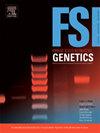使用药物遗传学研究mdma相关死亡的兴趣和局限性:一个病例报告。
IF 3.1
2区 医学
Q2 GENETICS & HEREDITY
引用次数: 0
摘要
由于报道的结果范围广泛,以及MDMA毒性的潜在特异性,解释死后3,4-亚甲基二氧甲基苯丙胺(MDMA)的浓度仍然具有挑战性。因此,法医病理学家经常依靠大量证据来确定涉及MDMA的死亡原因和死亡方式的结论。考虑到这些问题,实施药物遗传学(PGx)检测可能是有益的。在这里,本报告讨论了与mdma相关的死亡,并探讨了在这种情况下实施药物遗传学(PGx)分析的好处和局限性。一名34岁的欧洲白人男性被发现死在家中,赤裸地躺在床上,尸体明显僵硬。采用液相色谱-串联质谱联用技术对MDMA和亚甲基二氧苯丙胺进行定量分析,测定浓度分别为3800和170 µg/L。对EDTA管采集的外周血标本进行PGx分析。细胞色素P450 (CYP) 2D6、1A2、2B6、2C19、3A4和儿茶酚- o -甲基转移酶(COMT)基因的深度分析(包括拷贝数变异分析)由Next Generation Sequencing (NGS)在Illumina MiSeq®测序仪上使用Pharmacogenomics社区面板(SOPHIA genetics®x RNPGx)进行。使用Sophia DDM®软件对所得数据进行分析。PGx分析显示CYP2C19的三个变异(rs75087398、rs12248560和rs11188072)导致CYP2C19 * 1/* 17基因型,预示着快速代谢表型,意味着更大的MDMA消除。此外,在COMT基因中发现了两个变异(rs4633TT, rs4680AA)。在文献中,rs4680AA或rs4680GA基因型的携带者与G等位基因纯合的携带者相比,酶活性较低。低COMT活性水平与MDMA心血管效应和生物学变化增加有关,包括低钠血症风险增加,这与死亡的潜在机制特别相关。尽管有这些发现,但目前可用的研究太少,无法得出任何明确的结论,这表明需要在这一领域进行进一步的研究,以充分了解所有的影响。此外,仅关注代谢酶可能无法完全解释MDMA毒性的所有变异性。一个整体的遗传方法是必要的,结合代谢酶和药理学目标,包括血清素,多巴胺和去甲肾上腺素转运体和受体。本文章由计算机程序翻译,如有差异,请以英文原文为准。
Interest and limits of using pharmacogenetics in MDMA-related fatalities: A case report
Interpreting postmortem concentrations of 3,4-Methylenedioxymethamphetamine (MDMA) remains challenging due to the wide range of reported results and the potential idiosyncratic nature of MDMA toxicity. Consequently, forensic pathologists often rely on a body of evidence to establish conclusions regarding the cause and the manner of death in death involving MDMA. Given these issues, implementing pharmacogenetics’ (PGx)’ testing may be beneficial. Here, this report discusses an MDMA-related fatality and explores the benefits and limitations of implementing pharmacogenetics (PGx) analysis in such cases. A 34-year-old white European male was found dead at home, lying naked on his bed in a state of marked rigor mortis. MDMA and methylenedioxyamphetamine were quantified using liquid chromatography coupled to tandem mass spectrometry at respectively 3800 and 170 µg/L in femoral blood. PGx analysis was performed on a peripheral blood sample collected in EDTA tube. Deep analysis of cytochrome P450 (CYP) 2D6, 1A2, 2B6, 2C19, 3A4 and catechol-O-methyltransferase (COMT) genes (including copy number variations analysis) was performed by Next Generation Sequencing (NGS) on an Illumina MiSeq® sequencer using the Pharmacogenomics community panel (SOPHIA genetics® x RNPGx). The data obtained was analyzed using Sophia DDM® software. PGx analysis revealed three variants in CYP2C19 (rs75087398, rs12248560 and rs11188072) resulting in a CYP2C19 * 1/* 17 genotype, predictive of a rapid metabolism phenotype, implying greater MDMA elimination. Additionally, two variants were found in the COMT gene (rs4633TT, rs4680AA). In the literature, carriers of rs4680AA or rs4680GA genotypes exhibit lower enzyme activity compared to those homozygous for the G allele. Low COMT activity level has been associated with increased MDMA cardiovascular effects and biological changes, including an increased risk of hyponatremia which is particularly relevant here regarding the potential mechanism of death. Despite these findings, there are currently too few available studies to draw any definitive conclusions, indicating a need for further research in this area to fully understand all the implications. Moreover, focusing solely on metabolic enzymes may not fully explain all the variability in MDMA toxicity. A holistic genetic approach is necessary, incorporating both metabolic enzymes and pharmacological targets, including serotonin, dopamine, and norepinephrine transporters and receptors.
求助全文
通过发布文献求助,成功后即可免费获取论文全文。
去求助
来源期刊
CiteScore
7.50
自引率
32.30%
发文量
132
审稿时长
11.3 weeks
期刊介绍:
Forensic Science International: Genetics is the premier journal in the field of Forensic Genetics. This branch of Forensic Science can be defined as the application of genetics to human and non-human material (in the sense of a science with the purpose of studying inherited characteristics for the analysis of inter- and intra-specific variations in populations) for the resolution of legal conflicts.
The scope of the journal includes:
Forensic applications of human polymorphism.
Testing of paternity and other family relationships, immigration cases, typing of biological stains and tissues from criminal casework, identification of human remains by DNA testing methodologies.
Description of human polymorphisms of forensic interest, with special interest in DNA polymorphisms.
Autosomal DNA polymorphisms, mini- and microsatellites (or short tandem repeats, STRs), single nucleotide polymorphisms (SNPs), X and Y chromosome polymorphisms, mtDNA polymorphisms, and any other type of DNA variation with potential forensic applications.
Non-human DNA polymorphisms for crime scene investigation.
Population genetics of human polymorphisms of forensic interest.
Population data, especially from DNA polymorphisms of interest for the solution of forensic problems.
DNA typing methodologies and strategies.
Biostatistical methods in forensic genetics.
Evaluation of DNA evidence in forensic problems (such as paternity or immigration cases, criminal casework, identification), classical and new statistical approaches.
Standards in forensic genetics.
Recommendations of regulatory bodies concerning methods, markers, interpretation or strategies or proposals for procedural or technical standards.
Quality control.
Quality control and quality assurance strategies, proficiency testing for DNA typing methodologies.
Criminal DNA databases.
Technical, legal and statistical issues.
General ethical and legal issues related to forensic genetics.

 求助内容:
求助内容: 应助结果提醒方式:
应助结果提醒方式:


